Fall Fly Fishing Tactics for Trout
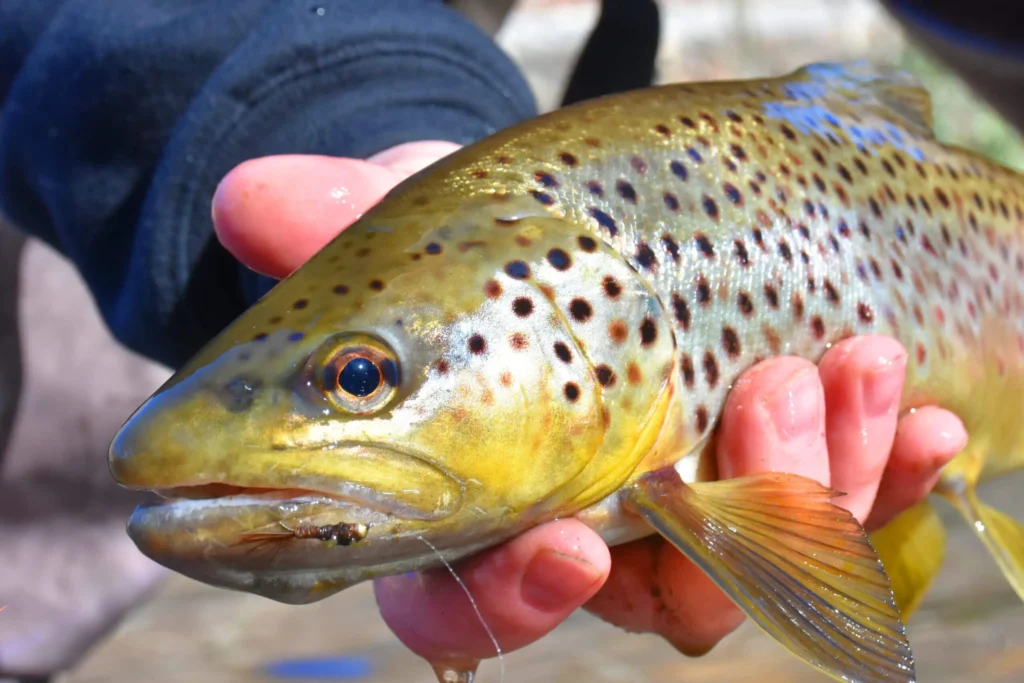
Fall is perhaps the most beautiful time to be on the water in the northeastern United States. With so much deciduous forest, the mountainsides are a mix of vibrant reds, yellows, and oranges. After a hot summer, the cool autumn nights and mornings are a nice reprieve, and the midday warmth is a welcome treat. Cooler water temperatures get fish on the move and feeding aggressively in preparation for the spawn and winter. This is one of my favorite times to be on the water.
Fall fly fishing success, though, is not always a given. There are a few things to consider before hitting the water so that you’ll be prepared to make the most of this wonderful time of year.

Watch the Weather and Prepare for Conditions
This might seem like an odd tactic to include for fall fishing, but it has become extremely important as we continue to deal with drought-like conditions well into the fall months throughout much of the Eastern United States. Simply put, the weather can make or break a fishing trip. If you have a fairly flexible schedule, or you can choose which days you work and which days you fish, try to time your trips with weather that will tip the odds in your favor. The misery of rain and cold will quickly be overshadowed by the fish you catch.
I know many anglers who are “fair weather fishermen.” Catching fish is secondary to simply spending a pleasant afternoon on the water. If given a choice between getting rained on and catching lots of trout versus a warm, sunny day and only a couple trout, they will invariably choose the warm, sunny day.
Personally, I’m not there yet. I will suffer torrential downpours and numb fingers if I know it will increase my chances at a monster wild brown. More than that, though, many fall hatches, such as various Baetis (Blue Wing Olives), typically occur on cloudy, rainy days.
Fall also presents some unique opportunities, such as trout feeding heavily in preparation for the spawn and winter, and they’ll feed for longer periods of time during those dark, overcast days. Even if water levels aren’t ideal, fish will be less spooky on dark days. There’s a reason this website is called Dark Skies Fly Fishing, by the way – because when the skies are dark, the fishing is best!
Note: We’re also called Dark Skies Fly Fishing for colloquial reasons, which you can read about here.
When you find that perfect combination of dark days and feeding fish, the fall months can provide an unforgettable experience. To enjoy it – or at least make it not so miserable – make sure to watch the weather and pack the appropriate gear so you’ll stay warm and dry and on the water during the best feeding windows.
The past few years, due to droughts across much of the region, streams and rivers have been running low and clear the majority of the time. This has made watching the weather and timing your fishing trip more important than ever. In my experience, every time we’ve gotten even just a little bit of rain, the fishing has turned on and been unusually good, and it has often stayed hot for a day or two even after water levels dropped again.
Approaching Spooky Trout

Water temps may be cooler in the fall, and fish may be feeding, but streams can still be running low and clear during the autumn months – and considering the drought-like conditions mentioned above, likely will be. And don’t forget, those fish just spent a summer in survival mode, hiding from predators, seeking thermal refuge, and sometimes taking shelter in very skinny water. Just because they’re more active in the fall doesn’t mean they’re less spooky.
How you approach the water is critical and can often mean the difference between fall fishing success and failure. Wear drab-colored clothing and approach low and slow. Whenever possible, use foliage to shield your approach.
It might seem comical to think of belly-crawling up to a trout stream, but that’s not necessarily far fetched. Many anglers spook more trout than they ever realize even when water flows are normal. They stomp on the banks, push through the water like a herd of cattle, and yell down to their buddy about what nymph they should tie on. As a result, a handful of trout may have vacated that pool or run before they’ve even had a chance to make their first cast.
Watching fisheries biologists survey streams was an enlightening experience in this regard. Often, as their team of four people worked up a small stream, I watched trout darting out ahead of them some 10-15 yards upstream. And the biologists weren’t making a ton of noise. They basically just walk upstream, electroshocking and collecting fish. But the vibrations they sent up through the creek bed were felt well in advance of their arrival. (You can read more about how streams are surveyed here.)
Many fly fishers ignore the impact of their approach or take for granted that trout can’t hear them coming. Something to consider, though, is that fish don’t have to bolt from a pool to be spooked. Alerted to your approach, many trout will simply take cover under a rock or hunker down in the bottom of a pool until you’re gone. And the larger and older the fish, the longer it usually takes for them to feel secure enough to begin feeding again.
Are You Enjoying This Article?
Stay up to date with the FREE Dark Skies Fly Fishing newsletter delivered three times per month to your inbox. Your information is never sold or shared to any third party and is used solely for the purpose of keeping you updated and informed about the latest news, tricks, tips, stream reports, and new releases from Dark Skies Fly Fishing.
Sign Up Now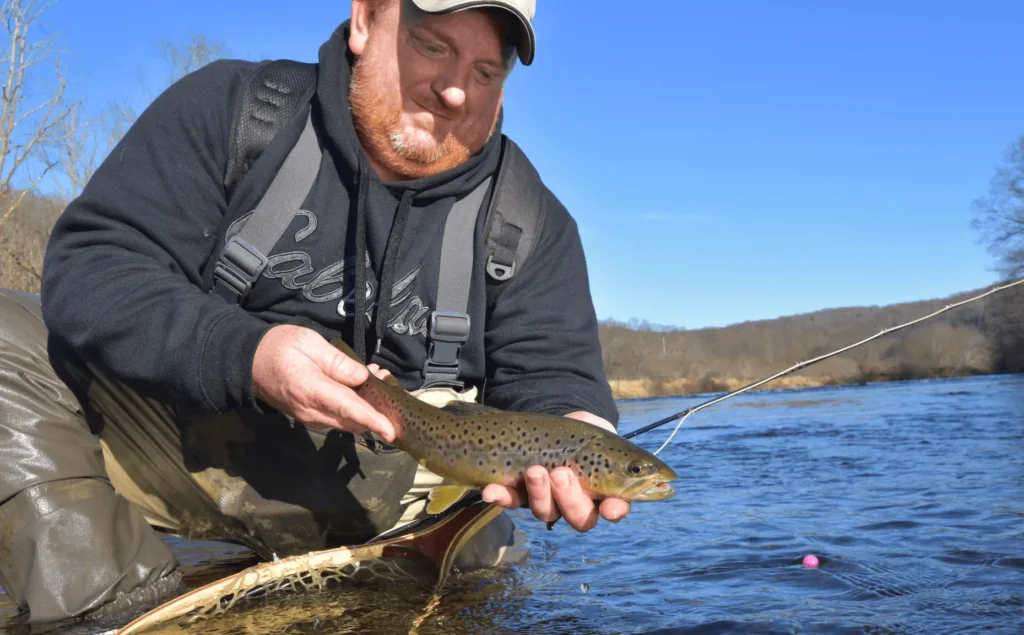
Be Versatile and Willing to Adapt
Last year, I tried to fish Pine Creek in Lycoming County right after a heavy windstorm. With a Euronymphing rig, it was nearly impossible to get a decent drift without snagging two or three leaves off the bottom. Instead of giving up, though, I switched to an indicator rig (using a leader designed specifically for fishing indicators is very helpful, too) and fished my nymphs 4-6 inches up off the bottom, and I ended up having a pretty good day. (Check out this article about how to fish an indicator rig.)
Those same leaves that make pretty photographs will eventually make their way into the water, which can make fall fly fishing as problematic as it is picturesque. If possible, I avoid streams that flow through heavily wooded areas – unless those woods are primarily conifers, of course. But once the leaves start to drop, I look for more open areas through fields and pastures, or I change my tactics.
Will leaves in the water ever stop me from fishing? No, absolutely not. But they’re definitely something to consider if you have options for where and how you want to fish. I carry several rods with me on every fishing excursion simply for this reason.
Sometimes how I want to fish isn’t the best way to catch fish that day. The main thing is to be prepared and willing to adjust when needed.
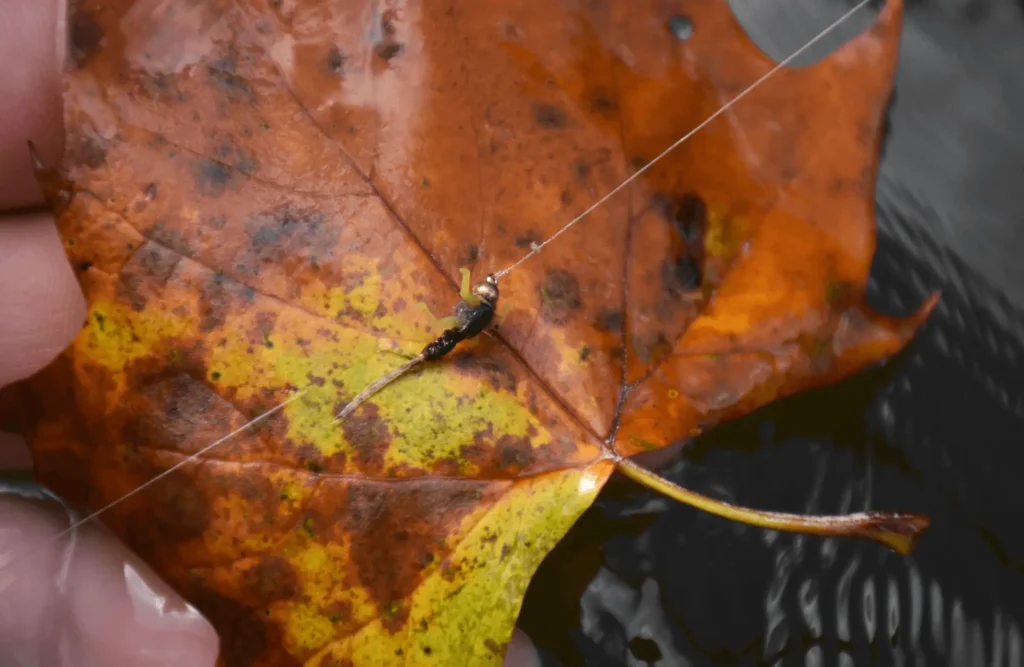
Use a Dry Dropper Rig
One adjustment I find myself making more and more when fall fly fishing is implementing a dry dropper rig in lieu of using an indicator. The dry dropper rig is tailor-made for fall fly fishing.
When water levels are low and clear, and fish are spooky, sometimes just the disturbance of your line hitting the water is enough to send fish diving for cover, let alone the splash of a plastic indicator. In these cases, a dry dropper is a great choice because the dry fly appears natural to the trout, and suspending the fly below enables you to fish the middle part of the water column, above the leaves on the stream bottom.
If I’m not Euro nymphing and instead relying on some type of indicator, the only time I won’t use a dry fly with a dropper is when there are too many leaves on the surface. In those instances, the dry fly grabs them on seemingly every cast, but a standard indicator will lift right out of the leaves without issue.
What I really like about the dry dropper rig in the fall is the ability to fish very light setups. I use a leader at least nine feet in length, tie a tippet ring on the end, and then attach a three-foot length of 6x-7x tippet. I then attach the dropper in one of three ways: to the bend of the dry fly, the eye of the dry fly, or with a perfection loop on the tippet a few inches in front of the dry fly. Here’s an article that discusses more techniques for fishing with a dry dropper rig.
But perhaps the biggest benefit of a dry dropper rig, which I alluded to, is being able to effectively fish that middle section of the water column. Fall is a great time to hit a Blue Wing Olive hatch or October Caddis. At some point in the day, usually from mid-morning through mid-afternoon, fish are looking up. In fact, many times I’ve even noticed an increase in trout elevated in the water column, and that’s when I know it’s time to switch to the dry dropper.
Leader and Tippet Adjustments
Another tactic for fall fly fishing that should not be overlooked is lightening your tackle. For me, 6x and 7x leaders and tippets become almost the rule rather than the exception. The only time I might go bigger is when fishing a hopper or Stimulator, which are large flies that can wear out a light tippet.
My typical fall fly fishing rig for dry flies is a 9-foot tapered leader with a 1mm tippet ring on the end. I then tie a 3-4-foot section of 6x or 7x tippet to the tippet ring. Some might frown upon the use of a tippet ring in this situation, but the 1mm creates no extra disturbance on the water and is so light that it rarely even breaks surface tension.
If I’m fishing bigger streams and conditions are extreme, meaning water is so low and clear that fish are nearly impossible to approach, I’ll lengthen my leader to 12 feet, still use a tippet ring, and lengthen the tippet to 5-6 feet. I don’t like using a tippet much longer than that, though, because you tend to lose control and accuracy. It becomes just a little bit harder to land the fly exactly where you need to, and during extreme conditions, you may not get more than one attempt.
On smaller streams – 10-20 feet wide, for example – the length of your leader and tippet isn’t as important. Definitely lighten up your presentation, of course. But on small streams, how stealthily you approach and how softly you can land your fly in front of the fish will ultimately determine whether the fish takes or spooks. And sometimes, fishing small streams when they’re extremely low and clear is just borderline impossible and you’re better off targeting bigger waters where at least you have a chance.
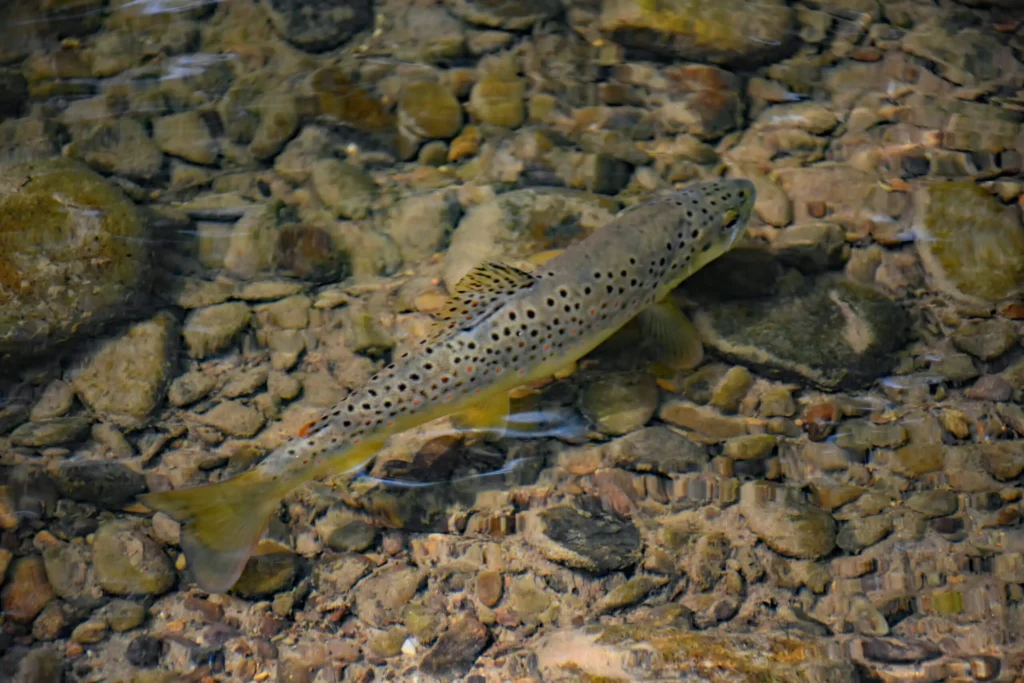
Overlooked Spots for Fall Trout
One of the most overlooked, productive water types for fall fly fishing is bank water. The slow moving water right off the bank –grassy banks, especially! – is where fall trout will often stage during feeding time.
Early fall is primetime for terrestrials, and many trout lie in ambush just waiting for hoppers, crickets, and ants to fall into the water. Trout will often hold in the deeper water just off these edges, too, and attack anything that falls into the shallow water just a foot or two off the bank. I’ve seen this happen too many times to count. I’ve seen a heavy splash or swirl in water only inches deep, but when I sneak over there, I see no trout. However, when I drift a fly down along that same edge, many times I’ve witnessed trout shooting out of the deep to attack the fly, sometimes traveling 5 feet or more to eat.
This is especially true in those long, deep, slow moving pools where trout congregate during summer’s hottest times. Trout move out of the warm shallows and seek thermal refuge in these deeper pools where the sun often does not penetrate all the way to the bottom. They’ll sit near the cool mud bottom of these pools until evening, when the temps drop enough to spur feeding. In these locations, trout will hunt along the edges of these big, slow pools and pick off terrestrials or other bugs that have gathered in those little eddies along the edges.
These are also great places to target during hatches this time of year. Mayflies and other insects typically emerge in the riffles, and you’ll find some trout up in those riffles feeding on them, but you’ll also find trout sipping spent flies and midges in the soft water only feet, and sometimes inches, from the bank. Catching these fish, though, requires a stealthy approach, soft presentations, and a willingness to adapt your tactics, if necessary.
Fall is a great time to fly fish in Pennsylvania and surrounding states. The Great Lakes Region, in general, is beautiful when the leaves start to change color. After a long, hot summer, the days and nights get cooler, and streams become fishable again. Insect activity generally picks up, too. Terrestrial fishing can be hot, and we often see hatches of various Baetis/Blue Wing Olive and caddis.
But fall fly fishing can be challenging, too. Even though trout are feeding heavily in preparation for winter, water conditions are not always favorable. To truly take advantage of the opportunities that fall presents, you have to be willing to change your approach and adapt your techniques to the situation. Do that and I know you’ll find that fall fly fishing can be quite rewarding.
Did You Enjoy This Article?
Stay up to date with the FREE Dark Skies Fly Fishing newsletter delivered three times per month to your inbox. Your information is never sold or shared to any third party and is used solely for the purpose of keeping you updated and informed about the latest news, tricks, tips, stream reports, and new releases from Dark Skies Fly Fishing.
Sign Up NowLooking to take your fishing to the next level?
Book a day on the water where we can show you how to read the water, make better presentations, catch more fish, and enjoy time spent outdoors more than ever before.
Book Now!

Thank you for the article. It was very detailed, which it needs to be. Feel good articles that don’t deliver the goods just can’t seal the deal. I fished pine last week in low clear water. The eagles and osprey loved it. 90% of the fisherman were frustrated and drew a blank. Using your prescribed methods kept me in the game each morning and evening. I used the soft stealth program you prescribed.
Thank you for reading and taking the time to comment. I truly appreciate your feedback and glad to hear you had success.
Funny you mention Pine Creek. I was there last Friday morning and had an eagle swoop down behind me so close that I instinctively shielded myself thinking I was about to be carried off! They can be bold along that stream!
Thanks again and continued good luck this fall!